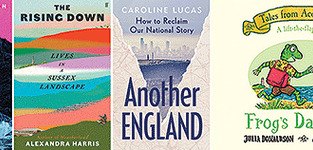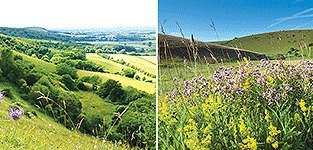Sussex Wildlife Trust: My Back Pages
April 3rd, 2021 I love old natural history books. It’s not just the information they contain. I love the smell, I love the binding.
I love old natural history books. It’s not just the information they contain. I love the smell, I love the binding.I love old natural history books. It’s not just the information they contain. I love the smell, I love the binding. For the past twelve months I’ve avoided Covid anxieties by burying my head in old books, scientific papers and traveller’s journals. I’ve been researching a book of my own, an account of my travels in search of what remains of the world’s iconic extinct animals. A journey which took me from the dark forests of New Zealand to the ferries of Finland and finally to an inflatable crocodile floating on Widewater Lagoon in Shoreham.
After spending long lockdown nights writing at my computer it was somewhat surreal to receive an advance copy of my book in the post this morning and to run my hands over its embossed cover. I finally filed it on my bookcase where it rubbed shoulders, and spines, with On The Origin of Species by Charles Darwin and Animal Magic by Johnny Morris.
My bookshelves sag with old natural history books. Just holding these tomes transports me to another time. Tucked away inside my battered (but beloved) copy of The Butterflies of Eastbourne (1928) by Robert Adkin is a map, which I always unfold eagerly as if I’ve discovered the concealed directions to some long-lost buried treasure. Indeed, in the book Adkin describes bounteous butterfly riches which could be found in the woodlands and downland coombes between Lewes and Eastbourne. You can almost hear Rudyard Kipling whisper of ‘something lost behind the Ranges. Lost and waiting for you. Go!’ At the time, many young explorers answered the call and Adkin claimed that ‘almost daily during the summer, one meets small armies of schoolboys each armed with a butterfly net.’
Perhaps Adkin’s eager Eastbourne entomologist army had been inspired by another of my favourite books. The Outdoor World (1900) by William Furneaux aimed to distract children from ‘victimising their schoolmates’ and give them ‘a taste for something better.’ Back in 1900, it seems pinning butterflies and collecting birds’ eggs fell into the ‘something better’ category. Furneaux encouraged young naturalists to make ‘killing bottles’ in which they could dispatch butterflies, and instructed children to ask the local chemist for some cyanide. The chemist will, Furneaux assures you, sell you cyanide if ‘he is satisfied with your intentions.’ Although it all sounds rather macabre now, this popular book went on to inspire a generation of young naturalists (and probably one or two aspiring Dr Crippens). Back on my bookshelf, I look at my book and wonder if — in 100 years from now — my own story will seem as distant and ridiculous as a world where schoolboys wielded butterfly nets and 10-year-olds could pop to the chemist to buy deadly poison.
By Michael Blencowe:Learning & Engagement Officer, Sussex Wildlife Trust
Sussex Wildlife Trust is an independent registered charity caring for wildlife and habitats throughout Sussex. Founded in 1961, we rely on the support of our members to help protect our rich natural heritage. Please consider supporting our work. As a member you will be invited to join Michael Blencowe on our regular wildlife walks and also enjoy free events, discounts on wildlife courses, Wildlife magazine and our guide book: Discovering Wildlife in Sussex.
It’s easy to join online at: www.sussexwildlifetrust.org.uk/join or T: 01273 497532.
Books©Charlotte Owen Sussex Wildlife Trust
After spending long lockdown nights writing at my computer it was somewhat surreal to receive an advance copy of my book in the post this morning and to run my hands over its embossed cover. I finally filed it on my bookcase where it rubbed shoulders, and spines, with On The Origin of Species by Charles Darwin and Animal Magic by Johnny Morris.
My bookshelves sag with old natural history books. Just holding these tomes transports me to another time. Tucked away inside my battered (but beloved) copy of The Butterflies of Eastbourne (1928) by Robert Adkin is a map, which I always unfold eagerly as if I’ve discovered the concealed directions to some long-lost buried treasure. Indeed, in the book Adkin describes bounteous butterfly riches which could be found in the woodlands and downland coombes between Lewes and Eastbourne. You can almost hear Rudyard Kipling whisper of ‘something lost behind the Ranges. Lost and waiting for you. Go!’ At the time, many young explorers answered the call and Adkin claimed that ‘almost daily during the summer, one meets small armies of schoolboys each armed with a butterfly net.’
Perhaps Adkin’s eager Eastbourne entomologist army had been inspired by another of my favourite books. The Outdoor World (1900) by William Furneaux aimed to distract children from ‘victimising their schoolmates’ and give them ‘a taste for something better.’ Back in 1900, it seems pinning butterflies and collecting birds’ eggs fell into the ‘something better’ category. Furneaux encouraged young naturalists to make ‘killing bottles’ in which they could dispatch butterflies, and instructed children to ask the local chemist for some cyanide. The chemist will, Furneaux assures you, sell you cyanide if ‘he is satisfied with your intentions.’ Although it all sounds rather macabre now, this popular book went on to inspire a generation of young naturalists (and probably one or two aspiring Dr Crippens). Back on my bookshelf, I look at my book and wonder if — in 100 years from now — my own story will seem as distant and ridiculous as a world where schoolboys wielded butterfly nets and 10-year-olds could pop to the chemist to buy deadly poison.
By Michael Blencowe:Learning & Engagement Officer, Sussex Wildlife Trust
Sussex Wildlife Trust is an independent registered charity caring for wildlife and habitats throughout Sussex. Founded in 1961, we rely on the support of our members to help protect our rich natural heritage. Please consider supporting our work. As a member you will be invited to join Michael Blencowe on our regular wildlife walks and also enjoy free events, discounts on wildlife courses, Wildlife magazine and our guide book: Discovering Wildlife in Sussex.
It’s easy to join online at: www.sussexwildlifetrust.org.uk/join or T: 01273 497532.
Books©Charlotte Owen Sussex Wildlife Trust
Comments (0)
No comments have been submitted yet.Why not be the first to send us your thoughts
Leave A Comment
Thank you for your comments, they will appear shortly once approved.
Recent Posts
Have You Seen...






